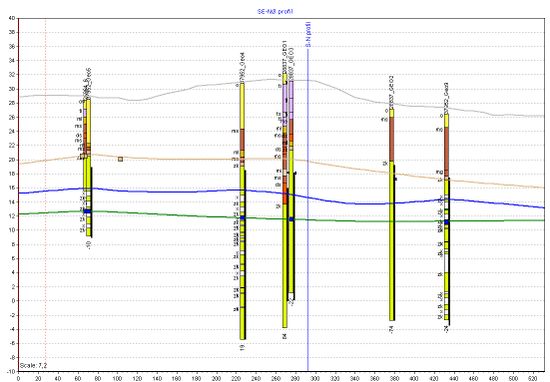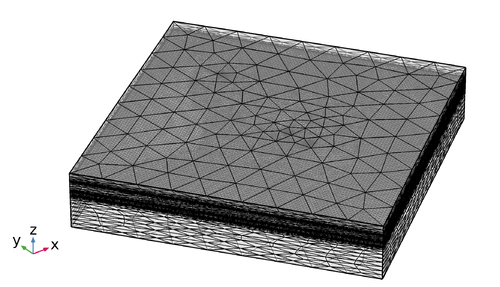Difference between revisions of "Model setup"
m |
m (→Steps to setup a model for flow and transport in fractured limestone aquifers: Reordered list) |
||
| Line 18: | Line 18: | ||
=== Formulation of the modeling objectives === | === Formulation of the modeling objectives === | ||
<div class="mw-collapsible-content"> | <div class="mw-collapsible-content"> | ||
| − | Before setting up a model, it is important to define the modeling | + | Before setting up a model, it is important to define the specific modeling objective(s). |
The choice of the model concept, model extent, modeling scale and included details should be closely linked to these objectives. | The choice of the model concept, model extent, modeling scale and included details should be closely linked to these objectives. | ||
| − | One should aim at including the most relevant features in the model, while keeping it as simple as possible. | + | One should aim at including the most relevant features in the model, while keeping it as simple as possible to address the modeling objective(s). |
The following list gives some examples for modeling objectives: | The following list gives some examples for modeling objectives: | ||
| + | * Delineate the capture zone of a well | ||
| + | * Improve risk assessment, e.g. for a contaminant threatening a drinking water well, in order to assess future actions | ||
* Analyze the distribution and potential spreading of a contaminant plume in an aquifer | * Analyze the distribution and potential spreading of a contaminant plume in an aquifer | ||
| − | * | + | * Test hypotheses related to the origin of a contaminant |
| + | * Interpret observed / measured field data | ||
* Analyze the influence of transient hydraulic conditions (annual variations, pumping in the area) on plume propagation | * Analyze the influence of transient hydraulic conditions (annual variations, pumping in the area) on plume propagation | ||
| − | * Develop and optimize a remediation strategy for the source zone | + | * Develop and optimize a remediation strategy for the source zone of a contaminated site |
| − | * Optimize a remediation strategy for a | + | * Optimize a remediation strategy for a contaminant plume |
| − | |||
| − | |||
| − | |||
</div> | </div> | ||
</div> | </div> | ||
<div class="collapsiblebar mw-collapsible mw-collapsed"> | <div class="collapsiblebar mw-collapsible mw-collapsed"> | ||
| + | === Conceptualization and setup of a conceptual model including geology and hydrogeology === | ||
| + | <div class="mw-collapsible-content"> | ||
| + | [[File:SE-NO_profil.jpg |thumb|550px|Example geologic profile of a Geoscene3D model.]] | ||
| + | ==== Geologic modeling ==== | ||
| + | Borehole data, outcrops, geophysical measurements etc. can give valuable information about the [[ Geology and properties of limestone | geology ]] at a site. | ||
| + | Bits of geologic knowledge can be connected to establish a geologic model, that shows different geologic layers and relevant geologic features (like inclusions or lenses). | ||
| + | Typically, these layers are characterized by different hydrogeologic properties. | ||
| + | The geometry can be stored as a CAD interpolation of the surfaces, that delineate the geologic layers. | ||
| + | Tools like GeoScene3D can be very useful to manage borehole data and to create interpolation surfaces. | ||
| + | The surfaces can be imported into the numerical model later on. | ||
| + | <br clear=all> | ||
| + | </div> | ||
| + | </div> | ||
| + | <div class="collapsiblebar mw-collapsible mw-collapsed"> | ||
=== Definition of the model scope === | === Definition of the model scope === | ||
<div class="mw-collapsible-content"> | <div class="mw-collapsible-content"> | ||
| Line 55: | Line 69: | ||
Then, a simple model can be applied, which can be improved as soon as new data is measured. | Then, a simple model can be applied, which can be improved as soon as new data is measured. | ||
| − | Modeling was an integral part in the limestone project. | + | Modeling was an integral part in the limestone project and already done at an early stage of the project. |
| − | Initially, a rough model based on first measurements and available data was setup | + | Initially, a rough model based on first measurements and available data was setup. |
| − | + | It was used for the planning of further field work and measurements. | |
| − | + | It also helps to identify further data requirements and to plan measurements that support the modeling. | |
| − | + | These additional measurements and data can then be incorporated in the model. | |
| − | |||
| − | |||
| − | |||
| − | |||
| − | |||
| − | |||
| − | |||
| − | |||
| − | |||
| − | |||
| − | |||
| − | |||
| − | |||
</div> | </div> | ||
</div> | </div> | ||
Revision as of 13:36, 19 February 2018
| Highlights |
|---|
|
Contents
Steps to setup a model for flow and transport in fractured limestone aquifersThis chapter gives an overview of the recommended steps to setup a model for the simulation of flow and transport in a fractured limestone aquifer. The following list shows the typical steps to setup a model for contaminant transport in a fractured limestone aquifer. Expand an item (button on the right) to get more information about it. Example: Setup of a COMSOL Multiphysics model for a contaminated site with a fractured limestone aquifer (Akacievej, Hedehusene)The setup of a discrete-fracture model in 2D in COMSOL Multiphysics using Coefficient Form PDEs is described in the following document: COMSOL provides also the possibility to include fracture flow in the Darcy's Law interface, while fracture transport can be included in the Transport of Diluted Species in Porous Media interface. We refer to the product documentation for more details. FEFlow provides a tutorial, that describes the steps of setting up a flow and transport model and how to include discrete fractures. DRAFT: The typical workflow for modeling a contaminated site will be demonstrated using an example field site close to Copenhagen. Example: Setup of models for a field site (Akacievej, Hedehusene) |

